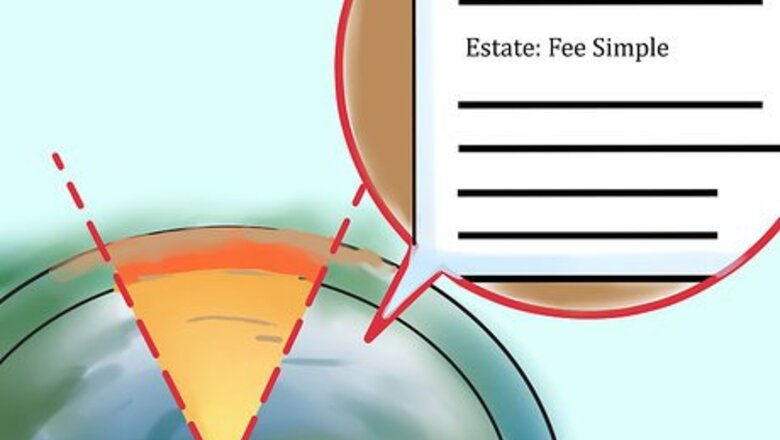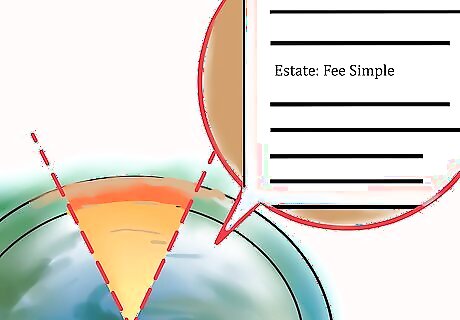
views
Preparing to Check for Mineral Rights

Understand fee simple title. Fee simple title is ownership of land that includes both the surface and the subsurface. It also includes the air above the property. If there are minerals below the surface of your property, then you will own the mineral rights if you own the land in “fee simple.” Fee simple title, however, can be carved up. Whoever owned the land in fee simple before you could have sold the subsurface rights to the land. This means that although you own the surface of your land, someone else could own the minerals beneath the surface. Furthermore, some minerals could have been sold while a prior owner retained others. Accordingly, when you purchased the land, you might not have been deeded all of the mineral rights.

Get your deed. To check if you own mineral rights, then you should start by getting a copy of your deed. If you do not already have a copy, then go to the county Recorder’s office and get a copy. Look to see if you were conveyed fee simple title to the property. If mineral rights are owned wholly or in part by someone else, then the deed should note that fact. You also should be aware that property deeds can sometimes be inaccurate. Although your property deed might state that you were conveyed “fee simple” title, the mineral rights might have been sold decades ago. For this reason, you shouldn’t trust your deed completely. Instead, you will probably have to perform a title search.

Hire a title company. You need to research the chain of title to find out if your deed is accurate. By performing a title search, you can check if the mineral rights were sold off at some point in the past. To find a title search company, look in your phone book’s Yellow Pages. You may also want to hire a member of the American Land Title Association, a national trade association. You can find a company by visiting the organization’s website and clicking on the “For Consumers” link at the top of the page.

Establish the parameters of the search. Title searchers will agree to search only so far back in time. For example, some title companies might only trace the chain of title for 40 years. You should clarify the parameters of the search because mineral rights might have been sold off 100 years ago or earlier. Check if the title company is willing to negotiate how far in the past they will search. If costs are a concern, then you might want to ask a title researcher to give you a “take-off.” A take-off comprises a list of the books and pages where the relevant deeds can be found. You can also specify that you only need a list of deeds that convey mineral rights, instead of all deeds in the chain of title.

Hire a lawyer. A lawyer is another option instead of a title company. Although a lawyer will probably be more expensive than a title company, you might want to establish a relationship with an attorney if you think you have minerals under your property. An experienced attorney can be beneficial. She can advise you on the law and help you lease your mineral rights should you find valuable minerals on your land. An attorney can also help you understand the details of your state law. For example, some states have created “marketable record title” laws which could extinguish a prior ownership interest in your land. If someone else owns the mineral rights under your land, then an attorney could help you use state law to get control of those rights. To find an experienced mineral rights attorney, use the referral program run by your state’s bar association. With some referral programs, you call a phone number and talk to someone who takes down your information and identifies your legal need. Then that person connects you to a lawyer who specializes in your field. Other referral programs are run on the web, which you can search by lawyer specialty. If “mineral rights” is not a specialty you can use to search, then look for attorneys who specialize in real estate, property, or land use.
Checking a Chain of Title

Go to the Recorder of Deeds office. You can begin your title search by going to the office for the county where the land is located. You should call your town office if you are unsure where the Deeds office is located.

Ask the staff for assistance. Offices preserve their records in different ways. Some offices may store all or some deeds in an electronic format. In that situation, you can search for deeds on the computer. Other offices will still have all of their deeds bound in books. Show the staff a copy of your deed. Say that you want to search the chain of title to check for mineral rights. A staff member should be willing to show you how to search.

Find the deed that immediately precedes yours. To start searching the chain of title, you will begin with the land deed immediately before yours. If you bought the land from Mr. Wilson, then you will need the deed given to Mr. Wilson when he bought it from Mrs. Vigue. Read the deed carefully. Look especially for mention of minerals or subsurface rights being reserved or transferred. Read the whole deed, including any attachments or addendums.

Continue working backwards. After you find the deed between Mr. Wilson and Mrs. Vigue, look for the deed Mrs. Vigue received when she got the land from Mr. Udall. Continue to work backwards, creating a chain of title. You need to go as far back in time as possible. Ideally, you should search all the way back to the original land grant. You should probably get a copy of every deed in the chain of title. Deeds can sometimes be confusing to read. You don’t want to overlook something or feel rushed. By getting a copy of each deed, you can then study them in your free time or take them to a lawyer to look over.

Search other records if you reach a “gap.” A gap in the chain of title occurs when you find a deed where Party X transfers an interest in land to party Y, but you can’t find the source deed that gave land rights to Party X. This break in the chain of title causes a “gap.” You will have to look at other public documents to try and fill in the gap: Look at divorce records or probate files. People convey land by wills or in a divorce decree. You might have to go to the court clerk, instead of the clerk at the Recorder of Deeds, to find these records. Research tax sales. If the owner of a piece of property was delinquent on paying taxes, then the property may have been seized and sold as part of a tax sale. You can find tax sale records at the tax assessor’s office.

Perform a title search for mineral rights. If you find that mineral rights were severed from the fee simple estate, then you will need to move forward in time to locate the current owner of the mineral rights. Owners of mineral rights can transfer those rights to others. Accordingly, you shouldn’t assume that a person or entity that was given mineral rights in the past still holds those rights. For example, mineral rights to oil might have been sold in 1944 to a local oil company. Now you need to know who owns those rights today. The oil company might have gone out of business or might have sold the mineral rights to another business. By moving forward in your title search, you try to figure out who the mineral rights were conveyed to. You should probably enlist the help of a lawyer to find the current mineral rights owner. Finding the current owner of mineral rights is a little like finding a “needle in a haystack.” Your lawyer will probably have to search probate records and other court documents, which you may find difficult to locate.



















Comments
0 comment